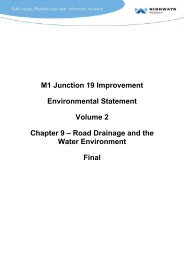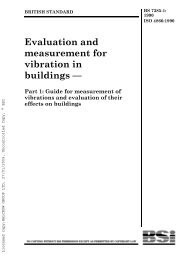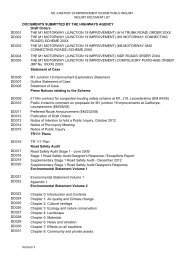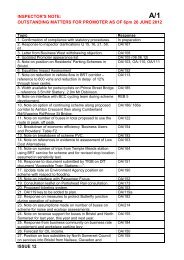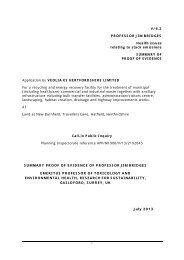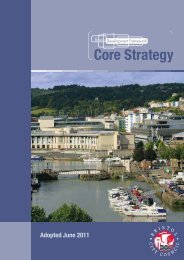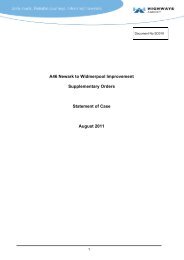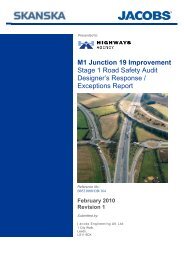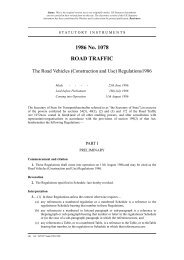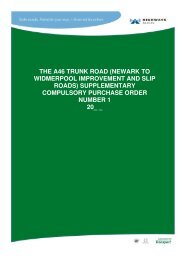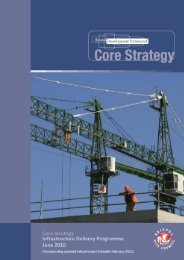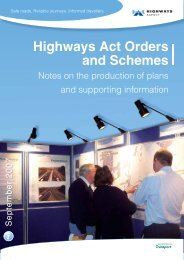Proof of Evidence of Mr James Willcock
Proof of Evidence of Mr James Willcock
Proof of Evidence of Mr James Willcock
Create successful ePaper yourself
Turn your PDF publications into a flip-book with our unique Google optimized e-Paper software.
Document Reference Number OA/13<br />
<strong>Pro<strong>of</strong></strong> <strong>of</strong> <strong>Evidence</strong> <strong>of</strong> <strong>Mr</strong> <strong>James</strong> <strong>Willcock</strong><br />
which match the surrounding materials, such as pennant stone walls and metal<br />
work, so that the character is retained and enhanced where possible. The small<br />
scale railway features, which make an important contribution to the character <strong>of</strong><br />
the area, would be retained and re-used. For further detail regarding the<br />
engineering interface <strong>of</strong> the heritage railway with the AVTM bus-way refer to the<br />
<strong>Pro<strong>of</strong></strong> <strong>of</strong> <strong>Evidence</strong> <strong>of</strong> <strong>Mr</strong> Bruce Slattery OA/4 covering scheme Engineering.<br />
Ashton Vale to Temple Meads (AVTM) Operational Effect on the Existing Bus<br />
Network<br />
6.9 As part <strong>of</strong> the engagement with bus operators during the development <strong>of</strong> the<br />
AVTM scheme, First Group have made an initial commitment to divert services X1,<br />
354 and 361 which currently operate between North Somerset and Bristol<br />
Marlborough Street Bus Station, onto the guided section <strong>of</strong> the AVTM Scheme<br />
before continuing via Prince Street onto their current route; and hence would gain<br />
the benefits <strong>of</strong> journey time savings between the A370 and the Centre. The<br />
diversion <strong>of</strong> the three services from Hotwell Road would therefore be a potential<br />
impact on passengers currently travelling along the corridor.<br />
6.10 Firstly, the diversion <strong>of</strong> the three services from Hotwell Road would still leave a<br />
number <strong>of</strong> services continuing to operate along the corridor. Excluding the Park<br />
and Ride services to Portway, there would still be 8 buses per hour in the peak<br />
along Hotwell Road, as well as bus service 505 and 506 operating along part <strong>of</strong><br />
Anchor/Hotwell Road to Southmead Hospital, which are unaffected. Secondly, the<br />
number <strong>of</strong> passengers using the X1, 354 and 361 services to travel within the<br />
Hotwell Road corridor is small – most passengers travel through the corridor<br />
between North Somerset and central Bristol. Further information about existing<br />
usage <strong>of</strong> bus service X1, 354 and 361 is contained in <strong>Mr</strong> Rob Thompson’s <strong>Pro<strong>of</strong></strong> <strong>of</strong><br />
<strong>Evidence</strong> OA/6.<br />
Ashton Vale to Temple Meads (AVTM ) BRT Service Operational Benefits<br />
6.11 The BRT service is proposed to operate up to every 6 minutes (10 services per<br />
hour). The investment in the BRT infrastructure will cut journey times, thereby<br />
reducing bus operating costs. The existing park & ride service 903 operates a<br />
service frequency <strong>of</strong> every 10 minutes in the AM peak and every 7 minutes in the<br />
PM peak, with a peak vehicle requirement <strong>of</strong> 6 vehicles. The AVTM BRT service in<br />
comparison will operate every 6 minutes in the AM and PM peaks and has a peak<br />
vehicle requirement <strong>of</strong> 5 vehicles. A saving <strong>of</strong> 1 vehicle from the 6 to 5 vehicles<br />
represents a 16% reduction in vehicle operating costs, while also yielding a 66%<br />
increase in service frequency in the AM peak and 16% increase in the PM peak.<br />
Page 15



